
* The Earth's Moon is a barren, lifeless body, but its bright presence in the sky has made it an object of curiosity since prehistory. In the 1960s and 1970s, during the era of superpower space competition, it was the target of streams of space missions, including six crewed landings. By the mid-1970s, interest in Moon exploration had faded out and wouldn't be revived for almost two decades.
* The general characteristics of the Moon have been long known. It has a diameter of about 3,480 kilometers, or 36.6% that of the Earth. It is 81 times less massive than the Earth, and has a surface gravity only a sixth as great. It has no liquid water and no atmosphere. In spite of its bright appearance, it is a generally dark body, with a reflectivity or "albedo" roughly that of coal dust.
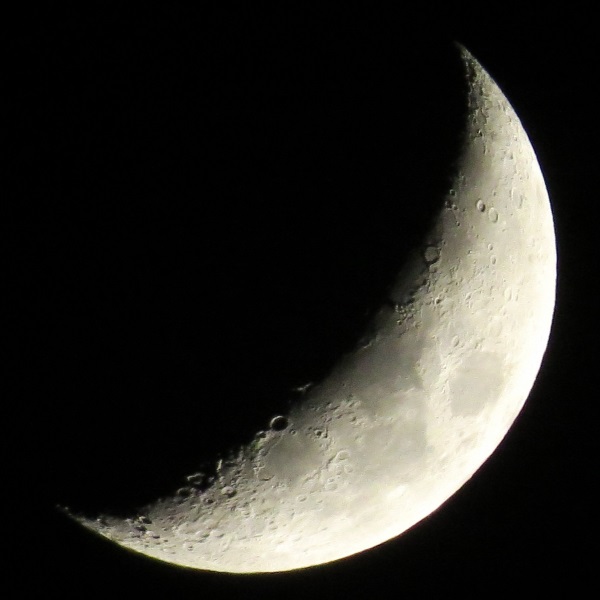
The Moon orbits the Earth at an average distance of 384,403 kilometers, performing one orbit around the Earth in 27 days 7 hours 43 minutes. The Moon is tidally "locked" to the Earth, meaning its rotation is the same as its orbital period, and so it always keeps the same face to the Earth. For this reason, almost nothing was known about the lunar "farside" until the Space Age. However, the Moon's orbit has a degree of eccentricity, ranging from 356,410 kilometers to 406,697 kilometers, exposing the east and west edges of the lunar farside during different parts of the Moon's orbit.
Temperatures during the Moon's long "day" can range from a low of -173 degrees Celsius before lunar dawn to a high of 127 degrees Celsius at lunar noon. The Moon's surface is rugged, featuring craters; mountain ranges; and plains known as "maria", from the Greek word for "oceans", though they are entirely dry. The maria appear to be relatively young regions, the product of impacts that ruptured the surface and created huge lava fields. The biggest distinct crater is "Bailly", about 295 kilometers wide and 3,960 meters deep. The biggest maria is "Mare Imbrium" or "Sea of Rains", which is about 1,200 kilometers wide. The tallest mountains, in the Liebnitz and Doerful ranges near the lunar south pole, are up to 6,100 meters tall, about the same as the Himalayas on the Earth.
Interestingly, unlike the Earth, the axis of the Moon's spin is almost perfectly perpendicular to the plane of its orbit around the Sun. This means there's no real variation in the day length at any latitude during the year; more significantly, there are shadowed regions, such as deep craters, near the poles where sunlight has never fallen. Icy materials scattered by the impacts of comets may have accumulated there, providing deposits of potentially valuable materials for future lunar colonization.
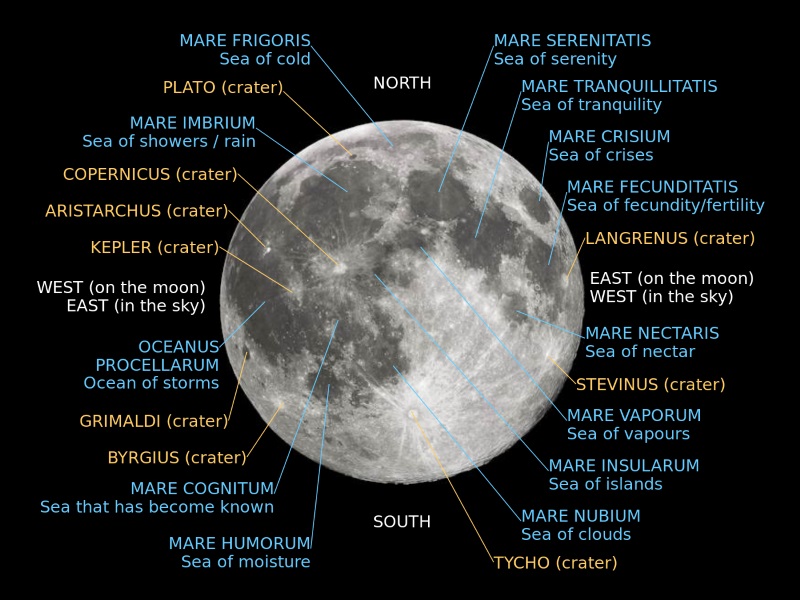
The Moon is a rocky world like the Earth, with a broadly similar mineral composition; but unlike Earth, the Moon is geologically inactive, with a small plastic core maybe 680 kilometers across, a deep solid mantle, and a relatively thin crust. The Moon has no magnetic field to speak of, though there are local magnetized regions due to the presence of magnetic minerals.
Early theories of the formation of the Moon suggested a number of scenarios: that it formed elsewhere and was captured by the Earth; that it and the Earth were formed together; and that it was split off from the Earth in the distant past. Current thinking, as mentioned previously, suggests that there was a collision between the Earth and a large body, at least as big as Mars, with the remnants of the "Big Thwack" re-forming into the Earth as we know it and the Moon. One puzzle about this is that the isotopic ratios of minerals found on the Moon and Earth are very similar, strongly suggesting a common origin -- and so there's some thought that the impactor gave the Earth a passing blow and went on, with the fragments forming the modern Earth and Moon.
BACK_TO_TOP* The Earth's Moon is the most familiar celestial body, known as "Luna" to the Romans and "Selene" or "Artemis" to the Greeks. It had been studied long before that, with its motions carefully mapped. Every rare now and then the Moon would pass in front of the Sun, blotting it out. Such solar eclipses often caused public consternation, as did lunar eclipses, when the Earth's shadow fell on the Moon. Ancient astronomers learned to predict the cycles of eclipses, on occasion using this knowledge to awe the citizenry.
The Greeks were the first to write down their thoughts about the body in any detail, determining that it was a spherical body in orbit around the Earth. In the third century BCE, the Hellenic scientist Aristarchus calculated a rough, but surprisingly accurate, distance to the Moon from observations of a lunar eclipse. In the first century CE, the Hellenic writer Plutarch suggested that the Moon was even inhabited by humans. A century later, another Hellenic scientist, Ptolemy, codified much of what was known about astronomy at the time, and his writings were influential for over a millennium. It wasn't until 1610, when the Italian scholar Galileo Galilei turned a simple telescope on the Moon, that its surface began to be inspected in more detail.
Following Galileo's initial sketches of the lunar surface, a series of more detailed maps were produced over the centuries:
* By the 18th century, few believed that the Moon had much of an atmosphere. When the Moon passed in front of, or "occulted", a star, the light from the star winked out immediately. If the star had been passing through a lunar atmosphere, it would have winked out more slowly. Similarly, nobody saw any real evidence of activity of any sort on the lunar surface.
Still, the idea that the Moon might be inhabited died hard. In 1835, a reporter named Richard Locke published a series of articles in THE NEW YORK SUN newspaper, claiming that John Herschel, son of the famous Anglo-German astronomer Sir William Herschel and a prominent astronomer in his own right, had built a huge telescope and used it to observe the Moon. Herschel, according to Locke, had found bizarre plants, animals, and a sort of "man-bat" creature that appeared to be intelligent. Of course, Locke had made the whole thing up, and the hoax was revealed a month after the initial publication of the articles.
After the Great Moon Hoax, other stories of trips to the Moon were written, though the authors didn't represent them as fact. In 1865, the French adventure novelist Jules Verne published FROM THE EARTH TO THE MOON, which envisioned a group of Americans building a huge cannon in Florida and blasting a group of space travelers into around the Moon and back to Earth. The whole scheme was technically unworkable, but it was the first time anyone had attempted to consider a Moon mission in detail.
In 1901, the British novelist Herbert George Wells published the second great work of fiction on lunar exploration, THE FIRST MEN IN THE MOON. The novel imagined two space travelers journeying to the Moon in a sphere covered with panels of an anti-gravity material named "Cavourite", where they encountered a hive society of insectlike lunar inhabitants. Verne was contemptuous of the "Cavourite" scheme, but Wells was trying to write a novel of imagination and social satire, not outline a plausible Moon mission.
With the emergence of pulp science-fiction magazines in the 1930s and 1940s, stories of trips to the Moon became commonplace. The most widely recognized work of fiction on lunar exploration in that period was George Pal's movie DESTINATION MOON, released in 1950, with the script written by prominent science-fiction writer Robert A. Heinlein. The movie was reasonably technically accurate for what was known at the time, and it encouraged the public that emerging long-range rocket technology might make flights to the Moon practical in a few years.
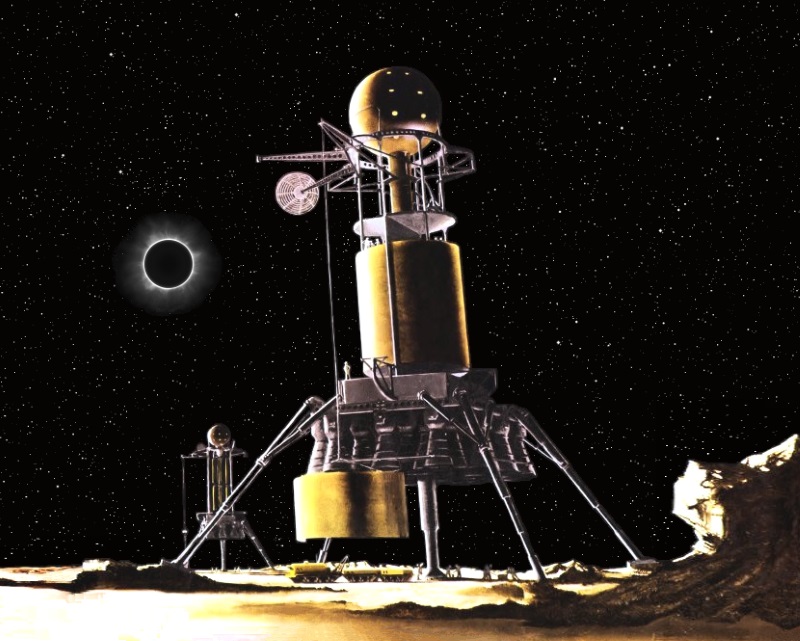
The enthusiasm was further reinforced by a series of articles on space technology published in the US COLLIER'S magazine from 1952 into 1954, with material produced by prominent space advocates -- most significantly Wernher von Braun, a rocket designer from Hitler's Germany who had signed up with the US following the war. The "Collier's Space Program", as it was later named, featured winged space boosters, giant space stations, and of course an ambitious crewed Moon landing, to be followed up by a Moon base. Von Braun, an energetic propagandist, would follow up the Moon mission outlined in COLLIER'S with other popular writings that generated enthusiasm for a mission to the Moon.
BACK_TO_TOP* After the Soviet Union launched the first artificial Earth satellite, "Sputnik 1", on 4 October 1957, the USSR and the US became gradually involved in a competitive "space race" to perform new space spectaculars. Following the first few satellite launches, in the summer of 1958 both countries then turned their attention to Moon shots. The US Air Force performed three attempts to reach the Moon, launching "Pioneer" probes on Thor Able boosters:
The Soviets performed their first Moon shot on 23 September 1958, with a two-stage Luna booster -- an R-7 intercontinental ballistic missile with an upper stage -- carrying a "Luna E-1" probe. The Luna E-1 was a sphere bristling with five antennas, and carrying a radio system; batteries; and a simple science payload, including a radiation detector, a magnetometer, a micrometeorite detector, and a kilogram of sodium powder to be released on the way to the Moon to provide a glowing trail. Total weight of the spacecraft was 360 kilograms. The 23 September launch attempt was a failure, the booster failing about a minute and a half into flight. Further attempts were made on 11 October and 4 December 1958, suffering the same general fate.
Back in America, the US Army was trying to succeed where the Air Force had failed. They launched "Pioneer 3" with a "Juno II" booster on 6 December 1958, but the booster did not perform as required. Like Pioneer 1, Pioneer 3 reached a high altitude, but did not hit the Moon.
The Soviets launched another Luna E-1 probe on 2 January 1959. The booster operated almost flawlessly, sending the probe on a path that took it to within 6,000 kilometers of the Moon and into orbit around the Sun. It released its sodium powder payload halfway to the Moon, providing evidence that all within eyesight could see of the Soviet mission. The spacecraft was named "Luna 1", or "Lunik" in imitation of "Sputnik". The flight wasn't quite perfect, since the probe was supposed to hit the Moon, not sail past it. The Soviets put the best face on the matter and announced that they had launched the first "man-made planet", renaming the probe "Mechta (Dream)".
The US Army launched "Pioneer 4" on 3 March 1959. The probe didn't hit the Moon either, but did manage to sail past it at a distance of about 60,000 kilometers.
The USSR tried to launch a "Luna E-1A" probe on 18 June 1959. It was a slightly improved version of the Luna E-1, with a weight of 385 kilograms. The spacecraft didn't make orbit. The next Soviet attempt, on 14 September 1959, was a bulls-eye, the probe actually hitting the Moon. It was of course publicly named "Luna 2". It was the first man-made object to reach another celestial body. The Soviet Union had just won the first race to the Moon.
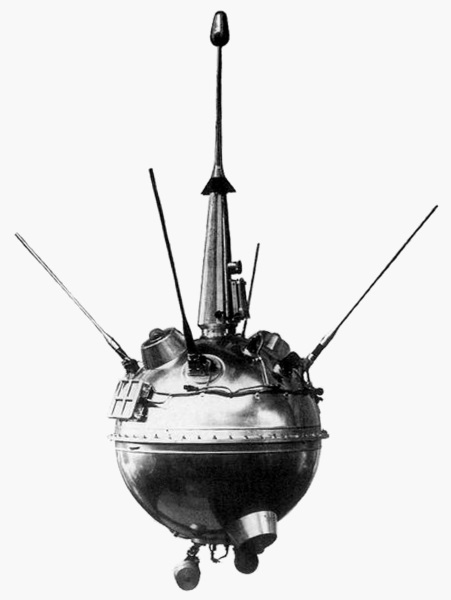
* These shots were really just technology exercises; the probes carried minimal payloads and could not return particularly useful data about the Moon itself. However, the Soviets further trumped the Americans by taking the first pictures of the Moon with a spacecraft. On 4 October 1959, the USSR launched a "Luna E-3" probe, which was a drum-shaped spacecraft with a skirt, a number of antennas, and a film camera system. It was designed to swing around the Moon, take pictures, then loop back towards Earth, develop the pictures on board, and relay them by radiofax to a ground station. The spacecraft had a weight of about 280 kilograms.
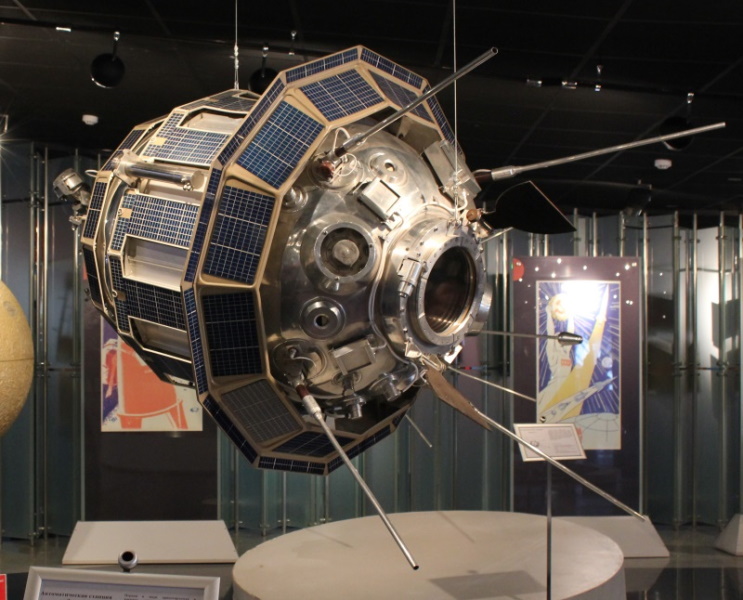
The mission was a success, with "Luna 3", as it was formally named, curving around the Moon on 7 October and taking pictures of its farside, with 29 images obtained. The images were of low quality and only 17 were useful at all, but they showed major features. The Soviets gave some of the most prominent landmarks nationalistic names such as "Tsiolkovsky", "Lobachevsky", "Lomonosov", and "Mendeleyev", but they were fair enough to add an international flavor to the map of the farside, with major landmarks given names such as "Giordano Bruno", "Maxwell", "Pasteur", "Jules Verne", and even "Edison".
The Luna 3 pictures suggested something that was confirmed by later spacecraft observations of the lunar farside. While the lunar nearside is dominated by the dark maria, the maria are generally absent from the farside. The difference seems too great to be explained away as a mere roll of the dice, but so far no one has come up with a persuasive explanation of why this difference exists.
The Soviets would try to launch two more Luna E-3 probes, one on 15 April 1960, the other four days later, on 19 April 1960. Neither made orbit, with the second launch failure resulting in spectacular fireworks. That was the finale of the first series of Soviet Luna probes.
BACK_TO_TOP* Following the less-than-stellar US Pioneer Moon shots, the US National Aeronautics & Space Administration's Jet Propulsion Laboratory (NASA JPL) initiated a second series of Moon shots, designated "Ranger".
The Rangers varied somewhat in configuration, but most of them weighed 305 kilograms and looked like ocean buoys, with a tower of instruments sitting on an octagonal bus compartment that was shaped like a big eight-sided hatbox. The bus contained control and power systems, thrusters, and vidicon-tube TV cameras to take pictures of the Moon. There were two solar arrays that unfolded like wings on each side of the bus, and a dish antenna that hinged down from the bottom of the bus.
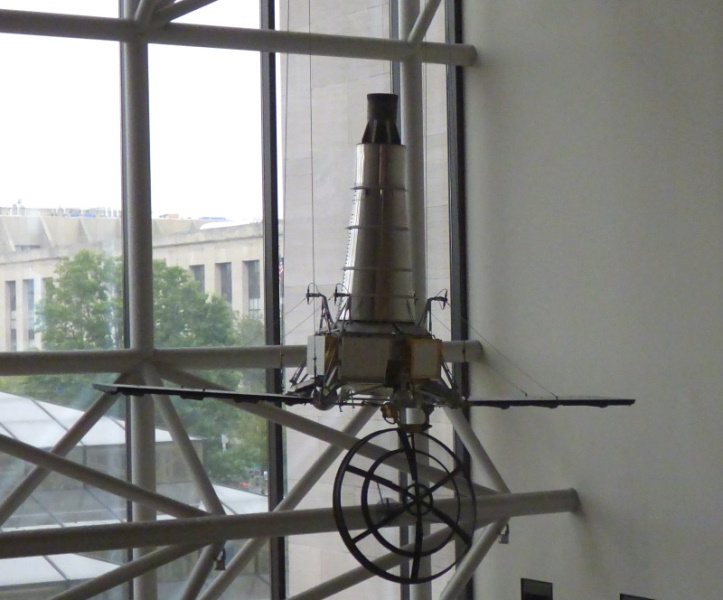
The Ranger program got off to a bad start:
JPL, under fire, halted Ranger launches to work on fixing the bugs. The priority of the effort was boosted on 12 September 1962, when US President John F. Kennedy announced in a speech at Rice University in Houston that the USA would put men on the Moon by the end of the decade. That put the space race between the superpowers into high gear.
Following the "Moon Speech", as it was later called, the Soviets shot off a few Moon probes of their own, initially focused on the "Luna E-6" Moon soft lander. The Luna E-6 probe was launched by the new Soviet Molniya booster, a more powerful derivative of the R-7; the probe looked like a bit like a genie's bottle, consisting of a spacecraft "bus" with an ovoid-shaped lander on top as the "cap". The Luna E-6 was battery-powered and had no solar sails. The bus would fall towards the Moon's surface, fire retrorockets, and then release the lander just before impact. The lander would bounce to the surface using an airbag system.
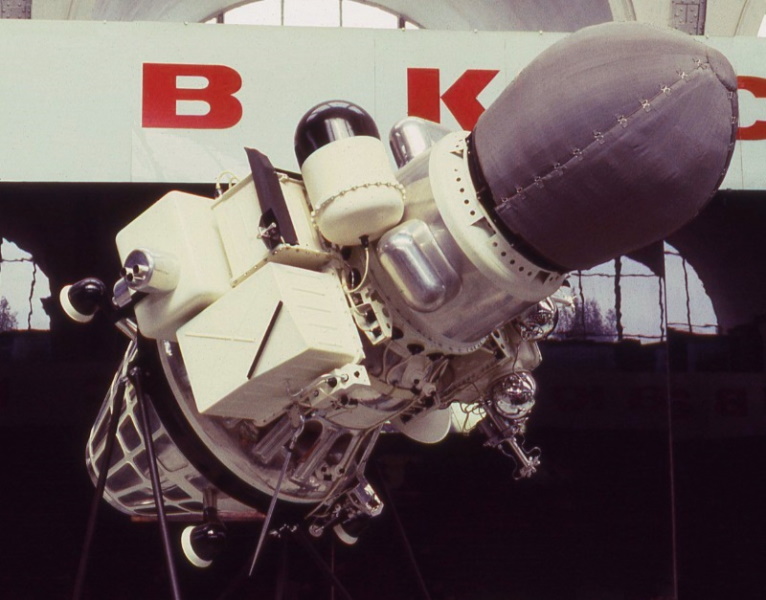
The soft-lander was a flattened sphere, weighing 85 kilograms. The top of the sphere was covered by four "petals" that unfolded after landing, righting the spacecraft so that its TV camera and communications antennas could be deployed. There were no other major instruments on board the lander except the camera. Like the bus, the lander was battery-powered. The design was simple and effective, the same general configuration being used by early Soviet planetary landers as well.
Unfortunately, the Soviets weren't having much better luck at the time than the US:
JPL went back to launching Rangers in early 1964:
The Ranger program was not all that scientifically useful, but it did give JPL valuable experience in conducting later, much more successful lunar and planetary missions.
BACK_TO_TOP* As the US Ranger series wound down, the USSR kept up their own Moon shots, with no great luck at first:
A different class of probe, "Zond (Probe) 3", was launched on 18 July 1965 and sent back photos of the lunar farside as it went into solar orbit. It was a Venera 3MV-1 planetary flyby probe, the same type of spacecraft that had been used for a Venus shot ("Zond 1") and a Mars shot ("Zond 2"), both of which are discussed later. The Zond 3 mission remains a bit puzzling, since it was completely out of the pattern for Soviet lunar exploration activities at the time. It may have been simply use of an available flight spare for propaganda and test purposes.
In any case, Zond 3 was followed by more Luna E-6 soft landers:
Persistence finally paid off. "Luna 9" was launched on 31 January 1966 and landed successfully in the Ocean of Storms, relaying panoramic TV shots of the Moonscape around it for three days. It was the first successful soft landing on another celestial body, and a justifiable source of pride for the Soviet space effort.
The Soviets attempted to launch their first true lunar orbiter, as opposed to the Luna E-3 Moon loop probes, on 1 March 1966. It was a "Luna E-6S" spacecraft, based on the same bus as that which carried the Luna E-6 soft lander, but with a sophisticated instrument payload of space physics instruments and no lander. It was battery-operated and had no camera. The spacecraft never made it out of Earth orbit, and was assigned the designation of "Cosmos 111". Further efforts were more successful:
That was the end of the second series of Luna probes. The USSR would then focus on their unsuccessful effort to send cosmonauts to the Moon, and a highly successful third generation of lunar probes.
* Although the Soviets publicly showed no enthusiasm for a crewed Moon mission, the USSR did indeed work on plans to do so. They kept the effort under wraps out of fear they couldn't beat the Americans in putting a man on the Moon -- and in fact, they couldn't.
The Soviet crewed Moon program is a complicated topic and is discussed in detail in a separate document. In brief, it was based on various derivatives of the Soviet Soyuz space capsule. The first was the "Soyuz 7K-L1", which was a stripped-down Soyuz that would be launched by a Proton booster to do a loop around the Moon. It didn't have the engine system to allow it to go into lunar orbit. In principle, it was to be followed by improved Soyuz lunar spacecraft launched by the big N-1 booster, but neither these follow-on spacecraft nor the N-1 went beyond a few test shots, not one of which came anywhere near the Moon if they got off the ground at all.
There were two launches of prototypes of the Soyuz 7K-L1 Moon loop spacecraft, designated "Soyuz 7K-L1P". They lacked re-entry heatshields and other operational kit. The first prototype launch was on 10 March 1967, with the spacecraft shot into a highly elliptical trajectory to simulate return from the Moon. The flight went well and was designated "Cosmos 146". The second prototype launch was on 8 April 1967. The upper stage didn't light; the spacecraft didn't leave low Earth orbit, falling to Earth two days later. The mission was designated "Cosmos 154".
After the prototype flights, the USSR moved to operational shots, though with little luck:
* The Americans were not idle while the Soviets pushed on with their crewed Moon program. NASA had been preparing two new series of Moon probes: a "Lunar Orbiter" that would circle the Moon and take mapping pictures, built by NASA's Langley center, and a "Surveyor" soft-lander, built by JPL.
Lunar Orbiter was a 384-kilogram spacecraft, with the primary payload consisting of a high resolution camera (HRC) and medium resolution camera (MRC). The cameras took images on film, which was developed in the probe and radiofaxed back to Earth. The Lunar Orbiters carried enough film for about 210 shots. The probes also carried micrometeoroid and radiation detectors, and their orbits were carefully tracked to obtain gravitational intensity maps of the Moon.
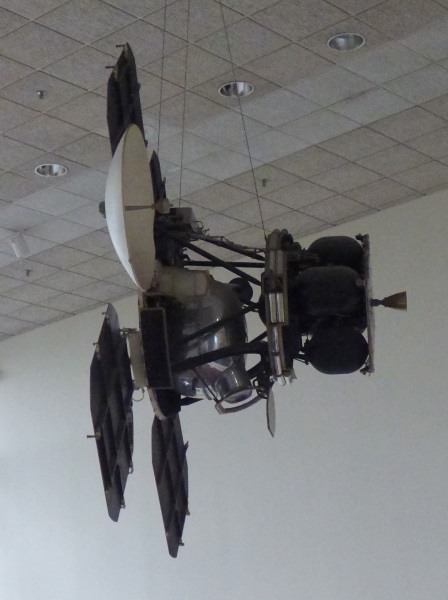
Five Lunar Orbiters were launched, all by Atlas Agena D boosters:
Lunar Orbiters 1 through 3 were put into mid-latitude orbits around the Moon to scout out possible crewed Moon landing sites. Lunar Orbiters 4 and 5 were put into near-polar orbits to obtain more comprehensive maps.
* In the meantime, JPL was also launching their Surveyor probes. They were spindly, insectlike craft, with three fold-out landing legs around a central bus with instruments; spacecraft power, control, and communications systems; and a solid-fuel retrorocket, surrounded by three liquid-fuel vernier rockets. Twin solar panels were raised above the probe on a retractable mast.
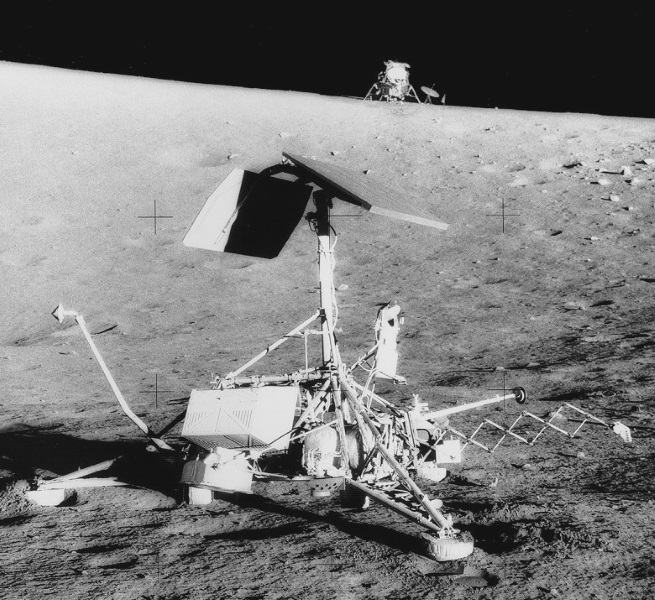
Seven were launched, all by Atlas-Centaur boosters, with two mission failures:
All the Surveyors had a TV camera. Surveyors 3 and 7 had a scoop on a robot arm that was used to test the integrity of the Moon's soil; Surveyors 5, 6, and 7 had a simple chemical analysis system to perform studies of lunar material. The Surveyor series was highly successful, demonstrating that the lunar surface was not covered with fine dust that would swallow up a crewed Moon lander, as some scientists had feared. It also provided the basis for more advanced US planetary landers.
* In the meantime, the US had also conducted two launches of small lunar orbiting satellites. These missions were focused on examination of particles and fields in the near-Moon environment, and did not observe the Moon itself:
The US would later put "Explorer 49" into orbit around the Moon, launching this spacecraft on 10 June 1973. However, Explorer 49 was not a Moon probe: it was designed for radio astronomy, and simply used the Moon to block out radio interference from Earth.
BACK_TO_TOP* The American Moon probes had been largely intended to pave the way for the crewed "Apollo" Moon missions, which were the prime focus of NASA in the 1960s.
The Apollo spacecraft was launched by the huge Saturn V heavylift booster. The spacecraft consisted of three elements: a conical "command module" capsule where the astronauts lived; a cylindrical "service module" to which the command module capsule was mounted, forming the "command & service module (CSM)", and which provided propulsion, power, water, and other resources; and an insectlike "lunar module (LM)" that would shuttle two of the three crew down to the lunar surface and back, while the third crewman remained in Moon orbit. This partition of functions was intended to reduce the amount of mass that had to be put down and returned from the lunar surface, which allowed the mission to be launched with a single Saturn V. It was a far cry from the giant vehicles imagined by von Braun in the COLLIER'S "space program".
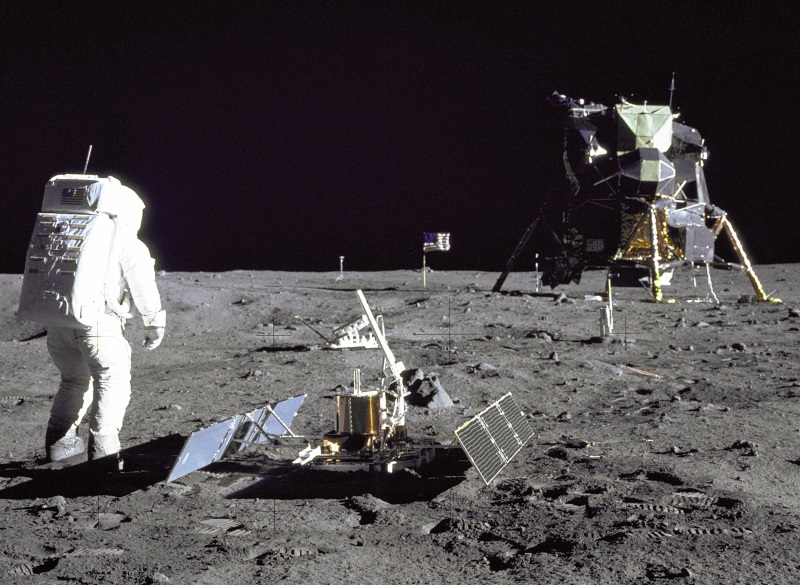
There were a number of uncrewed Apollo test launches; followed by two crewed Earth orbit missions, and two crewed Moon-orbit missions that did not involve a landing; and seven Moon landing missions, though one was a failure, the crew fortunately able to return to Earth safely after a series of excruciating cliff-hangers.
Following a preliminary series of uncrewed Apollo launches, the crewed flights included:
The soil and rock samples returned by the Apollo missions helped provide a much clearer vision of the history of the Moon, while laser reflectors left by three of the landings helped gauge the distance and changes in distance from the Earth to the Moon, as well as measure the drift of the continents on Earth.
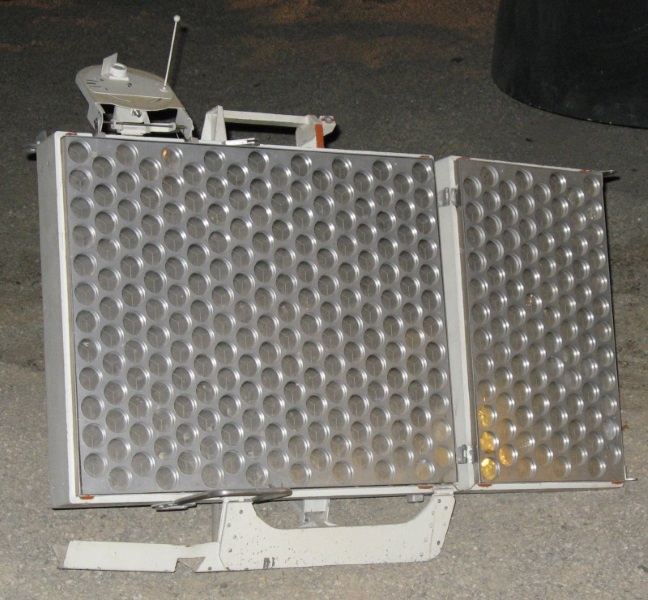
One of the minor discoveries was that, though there weren't pits of moondust as had been feared, the dust was still something of a nuisance. It was gritty, since there were no real erosion processes to round off the edges of the grains, and stuck to the astronauts' moonsuits like charcoal dust, which could threaten to upset the thermal balance of the suits. Once the astronauts got back in the lunar module and took off their helmets, the moondust had the smell of burnt gunpowder, and its abrasiveness could cause a nasty case of "hay fever".
There was controversy over the cost of the Apollo missions, which many judged disproportionate to the scientific value they provided. In reality, the Apollo missions were a political demonstration, intended to display American superiority to the Soviets, and science was never more than a secondary objective. Indeed, the only scientist among the dozen Americans who walked on the Moon was Harrison "Jack" Schmitt -- and the geoscience community had to raise a loud fuss to make sure he was included on the final flight. The rest of the Moon-walkers were effectively test pilots; however, they were given intensive geoscience training in preparation for the missions, and some of them became very enthusiastic about it.
BACK_TO_TOP* The Apollo 8 shot in December 1968 basically won the crewed Moon race for the Americans, with the Apollo 11 mission in July 1969 taking what wind was left out of the Soviet attempts to send a cosmonaut to the Moon. However, the Soviet Moon program continued on for several years.
The USSR tried to launch another Soyuz 7K-L1 Moon orbiter by a Proton on 5 January 1969, but it never made it to Earth orbit, though the re-entry module was recovered in Mongolia.
A first attempt was made to launch a "Luna Ye-8" Moon lander on 19 February 1969. The Luna Ye-8 consisted of a lander with a remote-controlled rover on top. The rover, or "Lunokhod", looked like a tub on eight wire wheels, each with its own motor and suspension, and a hinged solar panel on top. The rover sprouted two communications antennas and a magnetometer boom. It had a set of instruments, three panoramic cameras, and a navigation camera to allow it to be controlled by a five-man team back on Earth. It was designed to "sleep" through the dark lunar nights when the solar panel couldn't be used, with a radioactive heat source keeping the machine from freezing up.
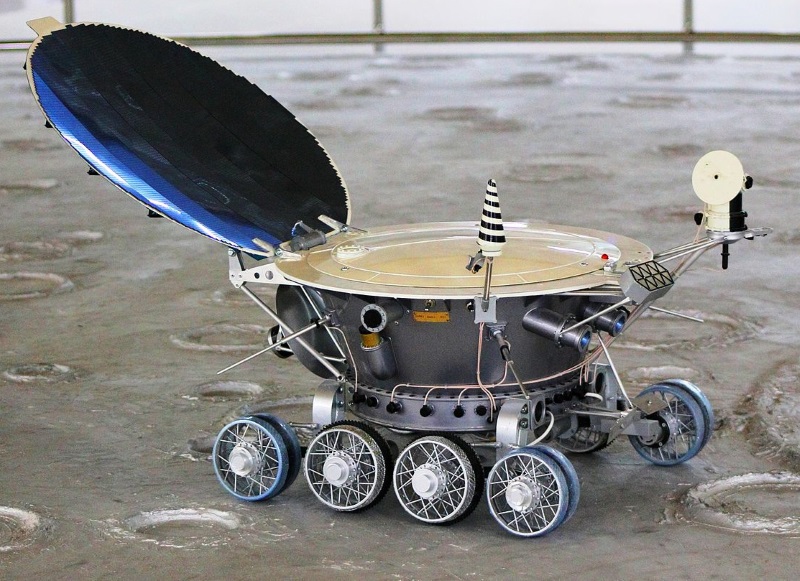
The entire spacecraft weighed 5,600 kilograms, with the rover itself weighing 1,815 kilograms. The Luna Ye-8 was launched by a Proton booster. The payload shroud and payload disintegrated, leading to loss of the Proton booster less than a minute into flight.
The Soviets launched the first "Luna Ye-8-5" lunar sample-return probe with a Proton booster on 14 June 1969. It was a big spacecraft, with a launch weight of 5,600 kilograms, and consisted of a four-footed lander that looked like a mass of spherical and cylindrical tanks, with a simple Earth-return "ascent stage" topped by a spherical re-entry module mounted on top. The re-entry vehicle would be loaded up by a sample collection arm fitted with a drill, and then the ascent stage would be shot back to Earth, with the re-entry module recovered by parachute. The lander stage would return temperature and other data until its batteries ran down. The Proton upper stage failed and the payload didn't make orbit.
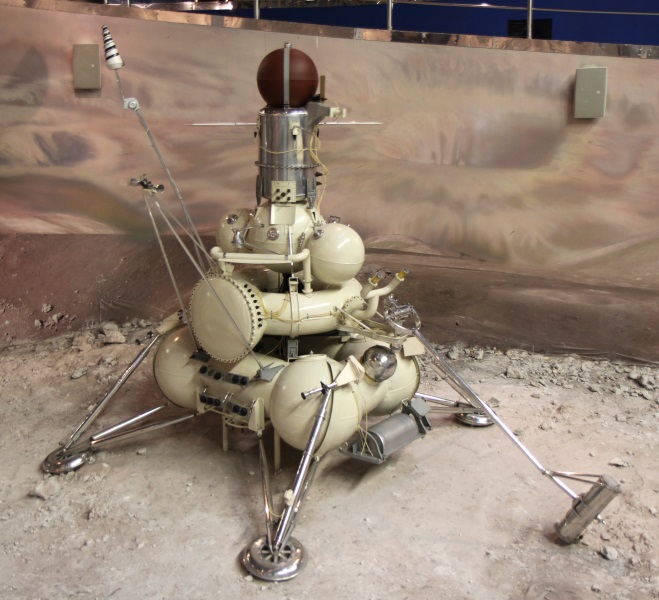
These launches set the pattern for the final set of Soviet lunar missions:
The Moon rover and sample-return missions were impressive accomplishments, in some ways were more the way of the future than the Apollo program. However, they weren't crewed Moon missions, and they received only modest public attention.
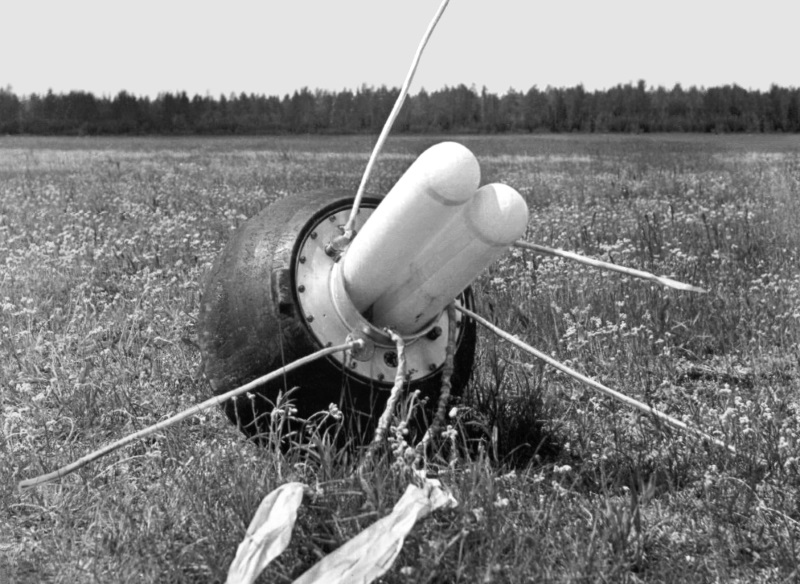
The Soviets continued to launch their highly successful robot missions at a low rate for a few years after the last Apollo landing:
Both the US and the USSR gave up on Moon exploration for the time being. Lunar exploration went into hiatus from 1975. NASA had considered ambitious follow-on plans for Moon exploration under the agency's "Apollo Applications Program", also known as "Apollo X", which envisioned Moon missions conducted with two Saturn V boosters, not just one. The first launch would carry an Apollo CSM on a Moon-orbiting flight, along with a new version of the LEM called the "LEM Truck". The LEM Truck was designed for a one-way mission, able to land on the Moon's surface but not take off again. Instead of an ascent stage, it would have relatively comfortable living quarters and supplies for a two-week stay on the Moon.
The second Saturn V would launch an Apollo CSM with a "LEM Taxi", which was more or less a standard LEM, improved to the extent that it could sit idle on the Moon for several weeks and still be able to safely send the two astronauts back to lunar orbit. The plan envisioned that astronauts would be able to range far from their base of operations, using a two-seat "lunar flying vehicle" or "Mooncopter", which used thrusters to allow astronauts to fly over the Moon's surface.
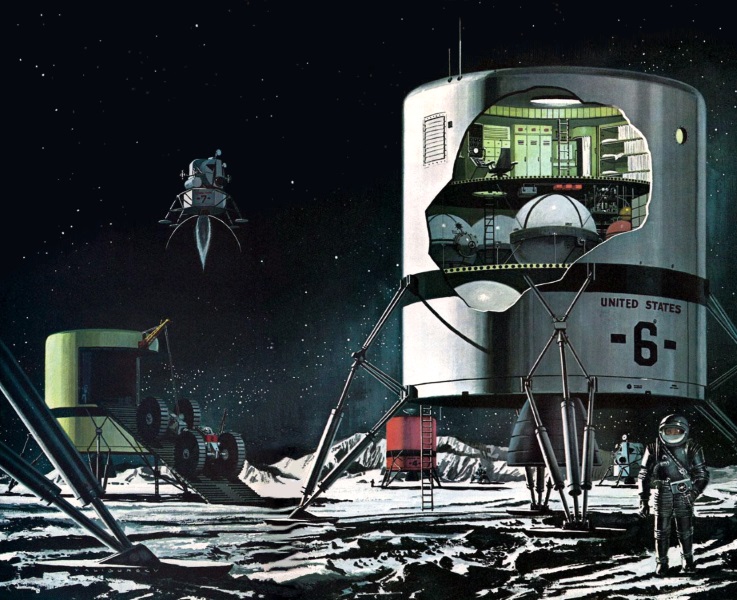
An alternate scheme involved a different version of the LEM Truck that carried a long-range lunar rover, the "Mobile Lunar Laboratory (MOLAB)", with living quarters and supplies for extended journeys over the Moon's surface. The ultimate goal was landing a permanent Moonbase module, the "Lunar Exploration System for Apollo (LESA)", launched by a Saturn V, carrying a MOLAB and powered by a nuclear reactor, with LESA capable of supporting at least three astronauts for at least 90 days. It didn't happen; nobody wanted to spend the money to put a base on the Moon.
BACK_TO_TOP